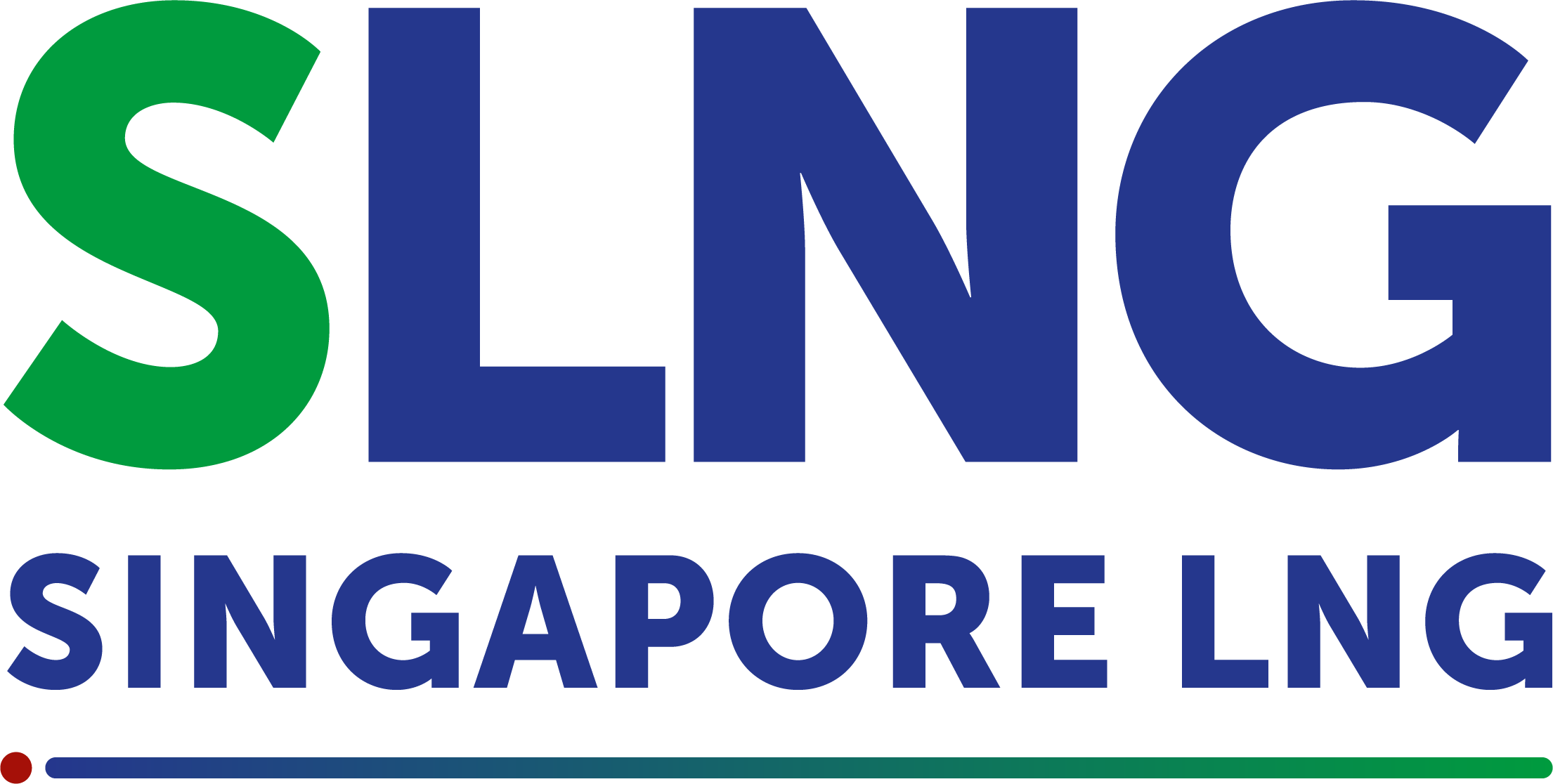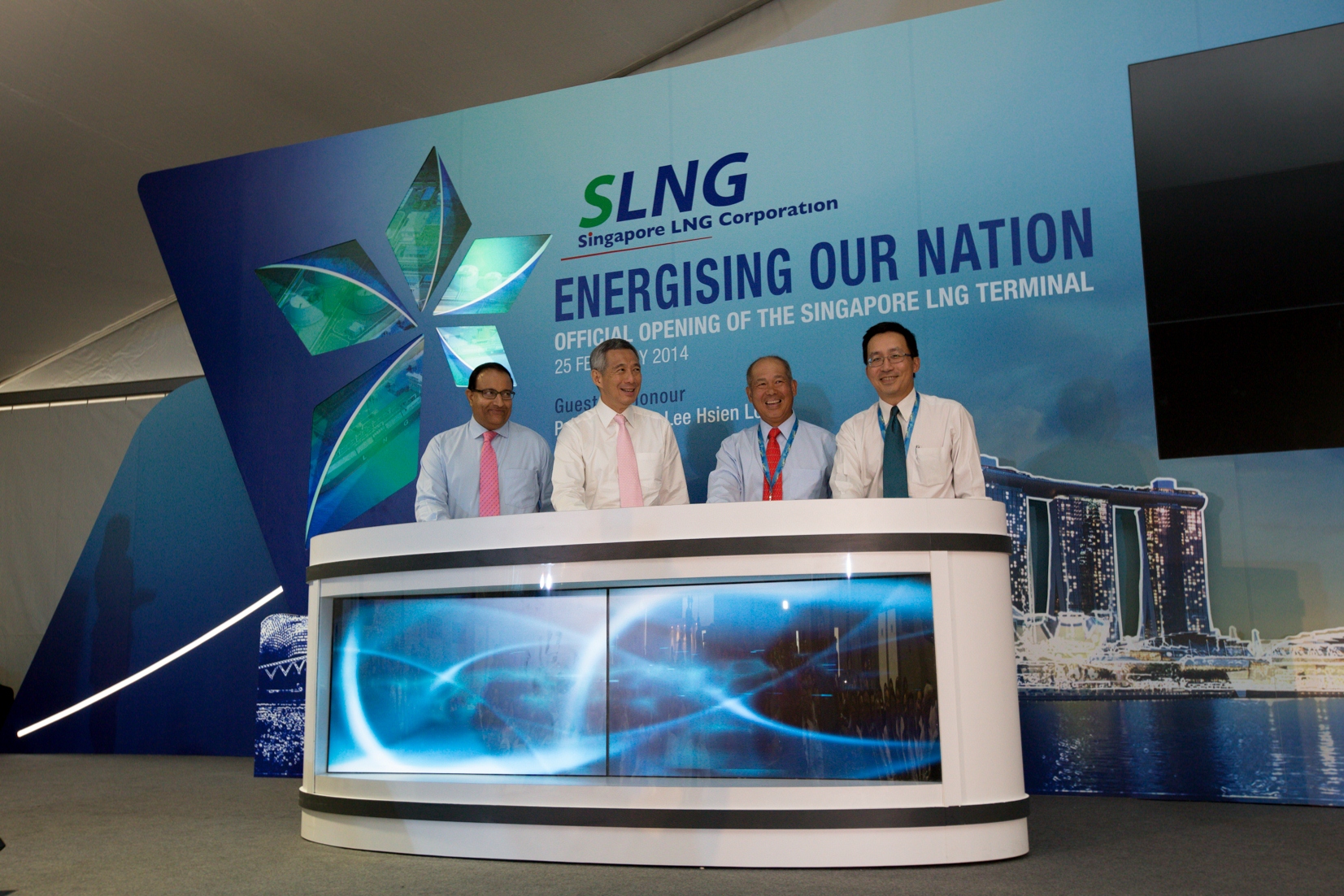Prime Minister Lee Hsien Loong Officially Opens The Singapore LNG Terminal
Terminal on track for further expansion to boost throughput capacity and potential as a regional LNG Hub
(Singapore, 25 February 2014) Prime Minister Lee Hsien Loong officially opened Singapore’s first Liquefied Natural Gas (LNG) Terminal this evening, at a ceremony held at the Terminal on Jurong Island. Some 400 guests attended the event, marking a new chapter in Singapore’s energy security and the future development of Singapore’s energy sector.
The S$1.7 billion Terminal, which commenced operations on 7 May 2013, is owned and operated by Singapore LNG Corporation Pte Ltd (SLNG). It is a critical infrastructure that allows Singapore to import natural gas from around the world, thereby ensuring the security of supply sources to meet Singapore’s current and future energy demand. In 2013, more than 90% of the electricity in Singapore was generated using natural gas.
To date, some 18 LNG vessels have called at the Terminal, delivering more than 56 million MMBTUs (Million British Thermal Units), or about 1.08 million metric tonnes, of LNG to Singapore. The LNG, from BG Group’s portfolio, has been supplied from a number of sources including Equatorial Guinea, and Trinidad and Tobago.
The facility, which is designed to serve multiple terminal users, has the potential to support the growth of Singapore’s LNG sector, and the development of Singapore as an LNG hub for the region. It will help to catalyse LNG-related business opportunities and create new jobs in the energy sector. These include LNG trading, bunkering and vessel cool-down services.
Mr John Ng, Chief Executive Officer of SLNG, said, “SLNG is proud to be given the responsibility of managing and operating such an important national infrastructure. We will focus our efforts to ensure that our facilities are designed, our plants are operated and our staff are trained to deliver the highest reliability and availability in sending out natural gas to the nation’s gas pipelines. I would like to thank our main stakeholders, the Ministry of Trade and Industry and the Energy Market Authority, for their tremendous support and guidance since the inception of the project; as well as our EPC contractor, Samsung C&T, for helping make this Terminal a reality.”
UPDATE ON FUTURE TERMINAL DEVELOPMENT
The Singapore LNG Terminal began operations in May 2013 with two storage tanks and an initial throughput capacity of 3.5 million tonnes per annum (Mtpa). The third tank and additional regasification facilities have been completed and are now operational, increasing the throughput capacity of the Terminal to 6 Mtpa. The Secondary Jetty is expected to be completed by the end of March 2014.
Plans are underway for the next phase of expansion of the Terminal, termed “Phase 3”, which will see the addition of a fourth tank and more facilities to bring the Terminal’s throughput capacity to at least 9 Mtpa. SLNG has started the tender process to select a suitably qualified contractor and the final investment decision, including the award of the Engineering, Procurement and Construction (EPC) contract, is expected in the second quarter of 2014.
End of Release
About Singapore LNG Corporation Pte Ltd
Singapore LNG Corporation Pte Ltd was incorporated by the Energy Market Authority in June 2009 to develop, build, own and operate Singapore’s first LNG Terminal on Jurong Island. The Terminal began commercial operations on 7 May 2013, and its core businesses include LNG terminalling, storage, regasification and send out services, as well as vessel cool-down services. Beyond these, SLNG will continuously explore new LNG business opportunities as it pursues its vision to become the Gateway for LNG in Asia, and establish Singapore as the LNG Hub for the region.
For more information, please visit www.slng.com.sg
For media queries, please contact:
Mr Simon Ang
Manager, Corporate Communications
Singapore LNG Corporation Pte Ltd
Email: SimonAng@SLNGCorp.com
Mobile: 9664 6161
Annex A
Interesting Facts and Figures about the LNG Terminal
Terminal’s Key Specifications
- The LNG Terminal is currently operating with three storage tanks, one main jetty and a throughput capacity of up to 6 million tonnes per annum (Mtpa). A second jetty will be operational by end March 2014.
- Plans for a fourth storage tank and associated regasification equipment have been announced. This will raise the terminal’s throughput capacity to at least 9 Mtpa.
LNG Tanks
- The first three LNG tanks are each 53 metres high and 90 metres wide. Each of these tanks can hold 180,000 cubic metres of LNG, large enough to fit two Airbus A380 aircraft, stacked one on top of the other, within it.
- A total of 27,832 cubic meters of concrete, 5,032 tons of steel reinforcement bars and 3,681 tonnes of steel plate was used for each tank.
- There are 562 steel piles for each tank’s foundation. Each tank sits on an area of 6,358 square metres. This is equivalent to 14 basketball courts.
- Two additional layers of nickel steel plate and carbon steel plate line the inside of the one-metre thick concrete walls of each LNG tank.
- The roofs of the tanks each weigh 1,200 tonnes. They were first built at ground level and then raised 53 metres high using compressed air. At a speed of about 200mm/minute, the raising of each roof took around four hours.
Pipes
- There is a total of 1,555 tonnes of piping in the pipe racks at the LNG terminal. When laid out straight, it is equivalent to the distance from Singapore to Malacca.
Safety Track Record
- During the first phase of construction of the Terminal, more than 15 million man-hours were worked on the project with zero lost-time injury. At its peak, there were 2,900 people working at the LNG terminal construction site.
Annex B
Background of LNG in Singapore – Chronology of Events
On 7 August 2006, Mr Lim Hng Kiang, Minister for Trade and Industry announced that Singapore would build an LNG terminal to import LNG to diversify its sources of energy and to meet Singapore's rising future demand for energy.
On 18 April 2008, BG Singapore Gas Marketing Pte Ltd was appointed as the LNG Aggregator for Singapore. In this role, BG would aggregate demand for regasified LNG from all end-users in Singapore and procure LNG supply for up to three million tonnes per annum (Mtpa).
On 30 June 2009, EMA formed Singapore LNG Corporation Pte Ltd (SLNG), to build, own and operate the LNG Terminal.
On 8 February 2010, SLNG awarded the contract for the engineering, procurement and construction (EPC) of Singapore's LNG terminal to Samsung C&T Corporation (Samsung). Foster Wheeler Asia Pacific Pte Ltd (Foster Wheeler) was also appointed by SLNG as Project Management Consultant.
On 31 March 2010, a groundbreaking ceremony was held at Jurong Island for Singapore’s LNG terminal. Mr S Iswaran, then Senior Minister of State for Trade & Industry and Education announced that six generation companies have committed to an initial tranche of around 1.5 Mtpa of regasified LNG. The six companies – Senoko Energy, YTL PowerSeraya, Tuas Power, SembCorp Cogen, Keppel Merlimau Cogen and Island Power Company (now PacificLight Power) – entered into long-term gas purchase contracts with BG Singapore Gas Marketing Pte Ltd.
On 2 November 2010, Mr S Iswaran, then Senior Minister of State for Trade & Industry and Education announced the decision to proceed with the construction of a third LNG storage tank at the terminal. He also announced that the six generation companies have made firm commitments to purchase an increased volume of 2 Mtpa of regasified LNG.
On 21 January 2011, SLNG announced the award of the contract for the EPC of the third LNG storage tank to Samsung. The third 180,000 cubic metre (m3) LNG tank, in addition to the two similar-sized tanks that were being built, would increase the terminal’s storage capacity to handle up to 6 Mtpa of throughput. This addition gives Singapore greater flexibility not just to meet its future gas needs, but also to pursue new business opportunities in the LNG market.
On 4 August 2011, SLNG announced the award of the EPC contract for the Secondary Berth Project to Samsung. The project, which forms part of the S$1.7 billion overall Singapore LNG terminal project cost, comprises a secondary jetty designed to berth LNG ships with a cargo capacity ranging from 60,000m3 to 265,000m3, and a tertiary jetty marine sub-structure designed for the future berthing of smaller LNG ships and barges with cargo capacity ranging from 10,000m3 to 40,000m3. The Secondary Berth Project will give added flexibility and value to the range of LNG terminal services that SLNG can offer its customers in Singapore and regionally.
On 24 October 2012, Mr S Iswaran, Minister in Prime Minister’s Office and Second Minister for Home Affairs & Trade and Industry, announced the plan to build a fourth LNG tank and associated facilities to boost the capacity of the LNG terminal to at least 9 Mtpa. This is to ensure that the infrastructure can cater to Singapore’s future energy needs.
On 29 October 2012, the Front End Engineering Design (FEED) project to define the scope of the expansion of the LNG Terminal’s send-out and storage capacities, kicked off. The expansion plans include the installation of additional facilities to increase the Terminal’s capacity to at least 9 Mtpa and the construction of a fourth tank.
On 27 March 2013, the first commissioning LNG cargo was received at the LNG Terminal. The commissioning cargo was procured from Qatargas and delivered by the Umm Slal, which is a Q-Max LNG vessel - currently the largest LNG vessel in the world. The LNG cargo was used to cool down and commission the LNG Terminal, to get it ready for full and continuous operations.
On 7 May 2013, the LNG terminal received its first commercial cargo, hence marking the terminal’s commencement of commercial operations. The commercial cargo was delivered by the Methane Kari Elin.
On 29 September 2013, the LNG terminal performed its first Vessel Cool-Down Service, following an agreement signed with MISC Berhad, a Malaysian shipping company. This is the first agreement for Vessel Cool-Down Services that SLNG has entered into, and the first cool-down was performed on one of MISC’s LNG ships, the Seri Bakti.
Download Full Press Release Here (106.62 KB)
Download Welcome Speech By Mr Bob Tan (37.94 KB)
Download Information on Methane Mickie Harbour (608.33 KB)

